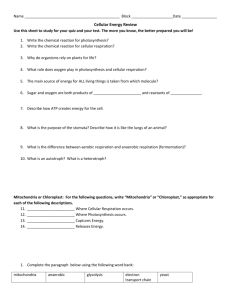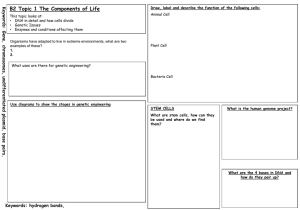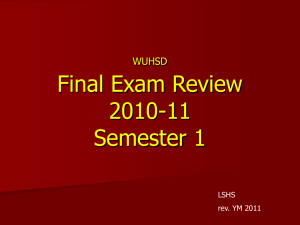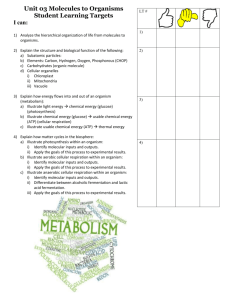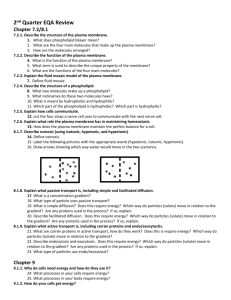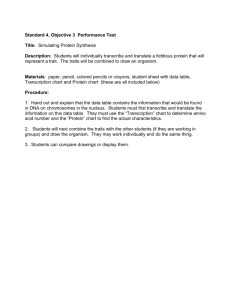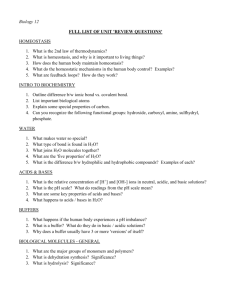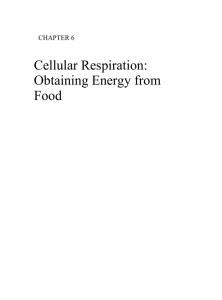EOC Study GUIDE
advertisement
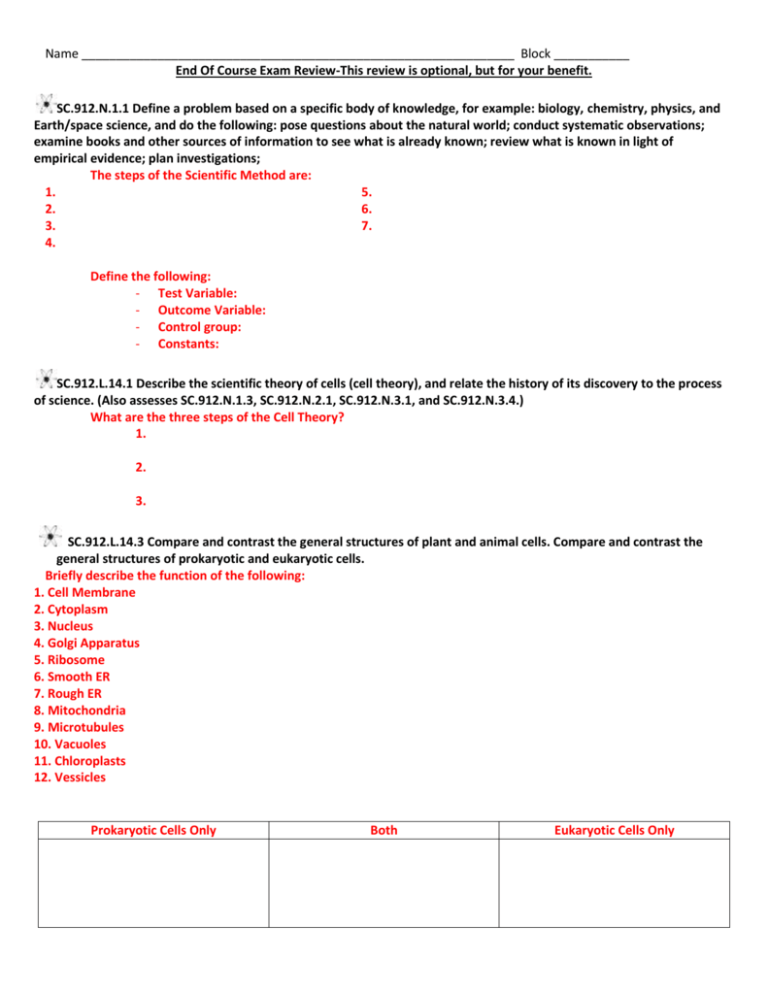
Name _______________________________________________________________ Block ___________ End Of Course Exam Review-This review is optional, but for your benefit. SC.912.N.1.1 Define a problem based on a specific body of knowledge, for example: biology, chemistry, physics, and Earth/space science, and do the following: pose questions about the natural world; conduct systematic observations; examine books and other sources of information to see what is already known; review what is known in light of empirical evidence; plan investigations; The steps of the Scientific Method are: 1. 5. 2. 6. 3. 7. 4. Define the following: - Test Variable: - Outcome Variable: - Control group: - Constants: SC.912.L.14.1 Describe the scientific theory of cells (cell theory), and relate the history of its discovery to the process of science. (Also assesses SC.912.N.1.3, SC.912.N.2.1, SC.912.N.3.1, and SC.912.N.3.4.) What are the three steps of the Cell Theory? 1. 2. 3. SC.912.L.14.3 Compare and contrast the general structures of plant and animal cells. Compare and contrast the general structures of prokaryotic and eukaryotic cells. Briefly describe the function of the following: 1. Cell Membrane 2. Cytoplasm 3. Nucleus 4. Golgi Apparatus 5. Ribosome 6. Smooth ER 7. Rough ER 8. Mitochondria 9. Microtubules 10. Vacuoles 11. Chloroplasts 12. Vessicles Prokaryotic Cells Only Both Eukaryotic Cells Only Name _______________________________________________________________ Block ___________ SC.912.L.14.7 Relate the structure of each of the major plant organs and tissues to physiological processes. Define the function of each of the following: 1. Flowers 2. Stem 3. Leaves 4. Roots 5. Xylem 6. Phloem 7. Cambium SC.912.L.14.26 Identify the major parts of the brain on diagrams or models. SC.912.L.14.36 Describe the factors affecting blood flow through the cardiovascular system. How might fever and dehydration affect a person’s cardiovascular system? What health factors may lead to decreased blood flow through the cardiovascular system? SC.912.L.14.52 Explain the basic functions of the human immune system, including specific and nonspecific immune response, vaccines, and antibiotics. Explain the steps the body takes to fight of an invading pathogen. Name _______________________________________________________________ Block ___________ In some cases, doctors will prescribe treatment options that do not include antibiotics. How is the doctor justified in offering the patient treatment options that do not include antibiotics for these cases? Specific Immune Response Nonspecific Immune Response SC.912.L.15.1 Explain how the scientific theory of evolution is supported by the fossil record, comparative anatomy, comparative embryology, biogeography, molecular biology, and observed evolutionary change. Explain how each of the following can be used as support for the Theory of Evolution: 1. Finding homologous structures amongst different species – 2. Finding different species that have some similarities in different areas of the world – 3. Examining the DNA of species – 4. The study of embryos of different organisms - SC.912.L.15.6 Discuss distinguishing characteristics of the domains and kingdoms of living organisms What are the levels of classification? (In order) Name _______________________________________________________________ Block ___________ Fill out the following table: Domain Bacteria Domain Archaea Domain Eukarya List and describe the 5 Kingdoms: 1. 2. 3. 4. 5. SC.912.L.15.8 Describe the scientific explanations of the origin of life on Earth Explain how Urey and Miller theorized life on Earth began: SC.912.L.15.13 Describe the conditions required for natural selection, including: overproduction of offspring, inherited variation, and the struggle to survive, which result in differential reproductive success Why is it important for animals to over-reproduce? Explain how natural selection is the driving force of evolution: SC.912.L.16.1 Use Mendel’s laws of segregation and independent assortment to analyze patterns of inheritance A male has brown eyes, but carries the recessive blue allele. A female only has the blue recessive alleles, which means she has blue eyes. The couple gets married and decides to have children. Answer the following questions; - Is the male heterozygous or homozygous? - Is the female heterozygous or homozygous? Name _______________________________________________________________ Block ___________ - Create a punnet square showing the ratio of offspring. - If they have 6 children, how many will have blue eyes? SC.912.L.16.3 Describe the basic process of DNA replication and how it relates to the transmission and conservation of the genetic information Label the following picture: Give a brief description of the 3 steps involved in DNA replication? a. b. c. Name _______________________________________________________________ Block ___________ Put the following steps of Transcription and Translation in order (1-5): _________ a. The process ends when the tRNA reaches a stop codon and stops creating amino acids. _________b. RNA polymerase unwinds part of the DNA segment. _________c. The tRNA begins to read every 3 nucleotides on the mRNA and creates amino acids. The amino acids combine together to form a chain of protein. _________d. mRNA attaches to one side of the DNA and creates a “photocopy” of the nucleotides by adding complimentary bases to the mRNA. _________e. mRNA detaches from the DNA strand and binds to the tRNA. SC.912.L.16.10 Evaluate the impact of biotechnology on the individual, society, and the environment, including medical and ethical issues. Stem cell research can save many lives, but can also lead to issues like cloning. Do you believe this research should be allowed? Why or why not? Please write at least 2-3 sentences. SC.912.L.16.13 Describe the basic anatomy and physiology of the human reproductive system. Describe the process of human development from fertilization to birth and major changes that occur in each trimester of pregnancy. Label the pathway (1, 2, 3, etc…) of gametes (egg and sperm) for male and female reproductive systems: Epidydimis _________ Fallopian Tube ___________ Urethra _______ Testes Ovaries _______ ______ Exits Body ________ Vas Deferens ___________ Uterus ________ List the developmental milestones an embryo goes through: 1st Trimester 2nd Trimester 3rd Trimester Name _______________________________________________________________ Block ___________ SC.912.L.16.17 Compare and contrast mitosis and meiosis and relate to the processes of sexual and asexual reproduction and their consequences for genetic variation. Label the following diagrams with the stages of meiosis and mitosis: Mitosis- Meiosis- Read the following statements and identify each as Mitosis or Meiosis: ______________________ A. Two divisions ______________________ B. Two daughter cells produced ______________________ C. Associated with growth and asexual reproduction ______________________ D. Four daughter cells produced Name _______________________________________________________________ Block ___________ ______________________ E. Associated with sexual reproduction ______________________ F. One division ______________________ G. Chromosome number is halved to produce gametes SC.912.L.17.5 Analyze how population size is determined by births, deaths, immigration, emigration, and limiting factors (biotic and abiotic) that determine carrying capacity Give an example of how an abiotic factor may impact the population dynamics of an ecosystem: If a snake species were introduced to an ecosystem where it had no natural predators, what long-term effect do you think it would have on the population dynamics of an ecosystem? Define carrying capacity and how it affects an ecosystem: SC.912.L.17.9 Use a food web to identify and distinguish producers, consumers, and decomposers. Explain the pathway of energy transfer through trophic levels and the reduction of available energy at successive trophic levels Identify which of the following statements are correct about this food web. A. There is more available energy in the seal than there is the phytoplankton. B. There is less available energy in the seal than there is the phytoplankton. C. There is less available energy in the zooplankton than in the penguin. Approximately how much of the energy is passed onto the next trophic level? ~ _________% SC.912.L.17.20 Predict the impact of individuals on environmental systems, and examine how human lifestyles affect sustainability. Explain how humans are impacting this world negatively, and what we can do to help preserve our Earth and resources. Name _______________________________________________________________ Block ___________ SC.912.L.18.1 Describe the basic molecular structures and primary functions of the four major categories of biological macromolecules. Students will identify and/or describe the basic molecular structure of carbohydrates, lipids, proteins, and/or nucleic acids Write which macromolecule the description is referring to in the space provided. _________________12. Does not dissolve in water, stores energy, important part of the cell membrane, steroids and waxes are examples. _________________13. Made up of amino acid chains, the amino acids determine its shape and function, enzymes are an example. _________________14. There are 3 types; Monosaccharide, Disaccharides, and Polysaccharide. Glucose is an example, has the ratio 1 Carbon: 2 Hydrogen: 1 Oxygen. _________________15. Contains; a phosphate group, five-carbon sugar, and nitrogen base. Its function is to store and send information. Some proteins (Enzymes) catalyze biochemical reactions. If a genetic defect prevented a catalyst from being created, what would you expect to happen in the cell? SC.912.L.18.9 Explain the interrelated nature of photosynthesis and cellular respiration What is the formula for photosynthesis? (Label the reactants and products) What is the formula for cellular respiration? (Label the reactants and products) Photosynthesis is broken down into two main steps, Light Reaction and Calvin Cycle. Fill out the following table: Light Reaction Does this need light? (Yes or No) Where in the chloroplast does this occur? What is the product of this reaction? (What does it make?) What type of energy does this reaction use? Calvin Cycle Name _______________________________________________________________ Block ___________ Fill in the following statements about Cellular Respiration and Fermentation: 1. The two organelles in which cellular respiration takes place in are the ______________________and the _______________________. 2. Glycolysis literally means “__________ _________________”. 3. During glycolysis, glucose is split into ________ (how many) molecules of ______________________. 4. After glycolysis, if oxygen is added into the reaction, it then goes through the ___________ _____________ and then the ____________________ _______________ ______________. 5. At the end of cellular respiration, a total of __________ ATP are created for the body to use. 6. After glycolysis, if no oxygen is provided to the cell, it then goes through _____________________. 7. In animals, fermentation results in the creation of __________________ __________________. 8. In yeast and bacteria, _________________ __________________ is usually the product of fermentation. 9. If cellular respiration does not complete, and fermentation occurs instead, only _________ ATP are created for the body to use. SC.912.L.18.12 Discuss the special properties of water that contribute to Earth’s suitability as an environment for life: cohesive behavior, ability to moderate temperature, expansion upon freezing, and versatility as a solvent Complete the following statements with the correct property of water; 1. ____________________ is the property of water in which water molecules are held together by hydrogen bonds. 2. The property of water in which water molecules bond to different substances is called _____________________. 3. Since water has a high _____________ ____________________, it can absorb and release high amounts of energy without temperature change. 4. Water is considered the Universal ____________________ because it can dissolve a large number of substances. 5. The pH of water is _________. Use the above properties to explain why water makes life on Earth possible and sustainable. (3-4 sentences please)




